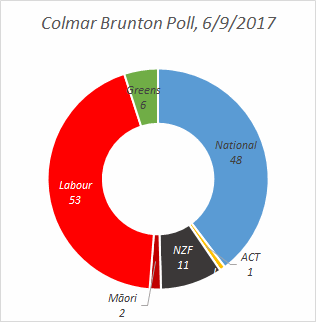So, the usual right-wing suspects are fomenting mischief about a possible National-Greens coalition, and it’s definitely not going away, at least not until Peters announces his decision, because it creates a false impression of pressure upon New Zealand First to side with National. Let’s discuss why and why not from a Green perspective, and I promise to take it seriously, possibly more seriously than it deserves. Advance warning: this will be long.
The whys are obvious: you could change the National Party’s trajectory, you could extract environmental concessions, you could prove that you care about the economy. (which is a very blue-green talking point: the Greens do care about the economy, they just disagree with National on what should be emphasized and how it should work)
These are worthy goals I agree with, and I will even concede that in the long term it may be possible to consider that, (probably at the beginning of a National government, however, not at the end) but I think that people who say the Greens should reach out are ignoring some relevant facts in favour of their dream coalition, and for those who voted National, are projecting their own party’s responsibility to develop a fair and just environmental and climate policy onto potential coalition partners.
The why nots, however, are numerous.
Let’s first talk about trust. The Green Party has, in fact, already approached National about working together on issues they can agree on, way back in 2009 when they first became government, (which was the appropriate time to have the discussion on whether and how the two could work together, I will note, something New Zealand First never respects) and managed to briefly convince National to extend Labour’s promise to subsidize insulation of homes, on the grounds that long-term it actually saves money on health spending. A sound investment, a classic win-win-win Green policy that National could share the credit for, and to their credit, they did take the Greens up on it. On that single policy. And then made no effort to continue the relationship, because for National, coalitions and allies are about political expediency, not about building long-term relationships, and it was not politically expedient for them to be seen as working too closely with the Greens. Sure, we now know there are the less-than-1%-of-National-voters signing that petition, but they would be risking a lot more enthusiastic and widespread support from certain businesses and farmers who are enthusiastic donors and volunteers.
Of course, that first failing is minor compared to things like the Todd Barclay scandal, Bill English rorting the rules (and if it wasn’t a rort, why did we change the rules to clarify it shouldn’t be done?) to claim a $48,000 housing allowance and only paying $34,000 back, the numerous instances the government has courted the oil industry, and their continued refusal to phase out fossil fuel power plants and fossil fuel extraction in New Zealand.
If the Greens can’t trust National to honour that agreement and to behave like a reasonable and ethical government, to take opportunities that would make them look centrist and reasonable without committing either party to any type of formal arrangement, how can they be trusted in a coalition?
Next, let’s talk about values/principles, and to be fair, let’s also talk about Labour and New Zealand First, too, because discussion of a National-Green coalition should, reasonably, be taken alongside its current alternative of a Labour-New Zealand First-Green coalition. We’ll return to whether the Greens can trust that alternative coalition at the end.
The National Party states its values here. You will note the strategic lack of mention about their alignment with farmers and business. You will also note that the environment is dead last on their list, with no mention of it “not being least.”
The Labour Party’s principles can be found in §1.2 of this document. (their website is currently still in campaign mode, so their values aren’t easily found) To summarise: democracy, communal ownership of natural resources, economic and democratic participation and access, co-operative economic relations, dignity & work, people over property rights, Te Tiriti o Waitangi, peace and social justice, human rights. These all sound pretty good, but we’ll get back to that.
And New Zealand First’s can be found here. As you’d expect, nationalism is first and populism makes the list, but there’s also some surprisingly progressive stuff in there from time to time, such as on education, health, welfare, and yes, even the environment. On the other hand, they also want lower taxes, a refocusing of foreign policy away from parts of the world outside of the pacific, (yet I’m sure it will still include the UK and US somehow, lol) and more referenda.
For comparison, the Greens’ fundamental values are also available here. (They aren’t yet on the new website, which also means they haven’t been updated to include the fifth fundamental value, Te Tiriti o Waitangi) The Greens keep their list short, but interpret those principles broadly. For instance, non-violence extends into not just supporting peace, but positive political campaigning, too.
Now let’s look a bit more holistically at how each grouping would or wouldn’t be compatible with each other.
National’s values start with “loyalty to our head of state,” an obvious reference to monarchism. The Greens are officially republicans. Not a good start. They continue on to national and personal security, which is coded language for militarism and tough-on-crime policing. Non-violence is right there in the Green charter, hmm, also pretty terrible match. Both parties do agree on equal citizenship, although the Greens want a bit more than “equal opportunity,” they believe in social justice, and that with limited resources on our planet, they must be used in a way that benefits everyone fairly, and this contrasts to a later National value, competitive enterprise. They do, largely, agree on individual freedom and choice, but National feels that this applies to the economy more than society, and the Greens feel the opposite. The Greens believe in consensus decision-making and social justice, and the National Party believes in limited government. They do, apparently, agree in principle to sustainable development, however the emphasis on that one is tricky. The Greens believe in sustainable development. The Nats believe in sustainable development. To me, this looks like a recipe for co-operation from the cross benches at best, until such a time as National modernizes its values further, or proves it can be counted on to prioritize sustainability.
Secondly, let’s look at the “three-headed monster.” On paper, Labour and the Greens are very compatible. Their values look mostly the same. In practice, the Greens’ problem with Labour is one of emphasis, to the point where many Greens view Labour as little better than National, a party changed by decades of compromise away from its values for electoral expediency that isn’t doing enough, and whose voters are targets to become future Green supporters. There is an uneasy peace between the two. Yes, they’re friends now, but that’s only because they’re worried about short term problems. It is an alliance of convenience, with Labour detractors viewing the Greens as too radical, unwilling to compromise and a bunch of dreamers. That’s not to say that there aren’t friendly feelings as well. The two parties are by a large margin each others’ preferred coalition partners, and not all members of either party are skeptics.
New Zealand First and Labour have a lot of commonality, too. They both agree that immigration rules are too loose, despite our immigration policy being so right-wing that US Republicans have it on their wishlist and the German AfD party of neo-nazi nationalists are using it as an example of what they’d like to do. They both agree in state intervention into the economy, in limited but actually effective environmentalism, in retaining state assets, in fighting corruption1, in improving skills for New Zealanders, in revitalizing the export economy, in working out the details of a Pike River re-entry, and in spending more in health and education. They disagree on some details in those areas, pretty substantially on Māori affairs, rights for women and queer people2, and Labour’s will-they-won’t-they flirtations with republicanism. But the big sticking point is probably tax. New Zealand First loves Labour’s economics on expenditure, but hates it on revenue. They are classic Muldoon-style don’t-tax-and-still-spend interventionists, wheras Labour believes in something approaching a fair taxation system, where state benefits accrue responsibilities to the state, and we decide on benefits and responsibilities democratically.
The hardest part of this alliance is New Zealand First and the Greens. Given my rathers, I would prefer that the Greens never had to work with New Zealand First. The parties could not be more different on immigration. This is an extension of the larger problem: Greens are out-and-out liberals, and New Zealand First are the most conservative party in Parliament. Seriously, conservative religious groups endorse them ahead of National and ACT. So a three-party coalition would be a government whose social policy focus was mainly on education and health, the areas where all three agree, with a much larger focus on economic reform away from neoliberalism and towards policies that benefit regional and rural New Zealand, which is the area where strangely, New Zealand First is much more enthusiastic than Labour, and would find the Greens an enthusiastic ally. There would likely be Green concessions on more hawkish immigration policy, in return for Labour and New Zealand First concessions on stronger environmental protections and more urgent action on climate change3. There is also likely to be three-party agreement on rail transport, and most of the core policy to solve the housing crisis, but with a three-way divergence on tax’s contribution to that problem, with NZF ideologically opposed, Labour hesistant, and the Greens ready to plunge in. What looks like an incompatible mess when viewed from both extremes might just be doable with a resurgent Labour Party in the middle to glue it all together.
And here I have essentially moved on to policy concessions. Some of the Greens’ most important policies, such as the Zero Carbon Act, a Capital Gains tax to adjust the housing market in concert with other policies, and so on, only seem realistic right now when negotiating with Labour. The best our happy little mischief-makers suggest that National would give the Greens is their levy on nitrate pollution, (although with no accompanying commitment to spend the results on transitioning to cleaner farming practice like the Greens propose) enhanced funding on predator-free New Zealand, a reversal on their loosening of water standards, and increased “targets” on poverty and emissions reduction. These policy concessions can be dismissed out of hand once we look at the fourth factor.
The Greens, a party run by its own base, have decided democratically to rule out a National coalition before the election, based on their record, and to avoid doubt. This is smart politics. The Greens have been hurt in previous elections by allegations they were considering working more closely with National. Even reaching out for the policy-based MoU was transmuted into a possible coalition by eager commercial political journalists looking to fill column-inches, and significantly confused supporters and hurt the campaign in 2011, which I know first-hand because I volunteered for it.
So, any discussion of a coalition with National also has to discuss the Green Party’s commitments to its own supporters and members, too, as these petitioners and right-wing commentators are suggesting that the Green Party break at least one of those commitments, which would probably result in the party splitting at best, or imploding at worst.
Right-wing commentators (who, conveniently, often have some background connection to groups closely aligned to National or ACT) have suggested that Metiria’s unfortunate resignation will leave James Shaw open to consider a more pragmatic deal. Firstly, that’s insulting to James, who is just as commited to Green values and principles as Metiria was, even if his policy emphasis is in a different area than her, it doesn’t mean he doesn’t care about her issues and support her stand for better treatment of beneficiaries. Secondly, it misunderstands the Green Party’s internal structure. The co-leaders aren’t elected dictators like in other parties. They formulate tactics and strategy, they lead caucus and are head spokespeople, but they don’t actually make coalition decisions, or decide the party list, or electorate selection, and they consult on those decisions they do make, so that the party is behind them, and their leadership is more about being head candidates rather than actually controlling the party. That work is for the party executive, the policy committees, the various co-conveners (“Co-Cos,” the equivalent of party presidents, branch presidents, and sub-group presidents) and the members.
Any coalition deal must pass a vote at a Special General Meeting. This means every branch sends delegates that are instructed by the consensus of that branch on the issues on the meeting’s agenda. (for AGMs, this includes whether to continue supporting the co-leaders, which is more of a symbolic tradition, as there is a hatred for backroom politics and spills within the party- which is why Kennedy Graham hasn’t been welcomed back immediately despite his credentials. For SGMs, it’s usually exclusively about the Greens’ position on supporting the next government) You need a 75% positive vote to pass, so a deal with National would need to be one with overwhelming support from Green members, not just however many of the 8 thousand-odd petition signers are actually Green members. There is no realistic way that anything National is realistically willing to offer the Greens would survive such a vote, even if we do slightly better policy concessions out of National than Farrar seems to think we would get, which I think probably represents a reasonable guess at National’s best unprompted offer to the Greens.
This isn’t to say that a National-Green alliance is permanently out of reach. But the ball is, and has been, in National’s court if that want to resume a productive relationship right now, not in the Greens’, and it will take longer than the duration of post-election negotiations to conclude. It would require a genuine transformation of the party towards a more blue-green posture, and is why the Green Party and CDU in Germany have been able to work together at the state level- because in Germany, bluegreens are actually influential within their political movement, they are trustworthy, and therefore there was values alignment and trust between the two parties that allowed a coalition to work, so it wasn’t just about a cynical policy alignment, like New Zealand First has previously favoured when working with National.
addition: Oh, and while we’re talking about betraying bases, let’s talk briefly about the Progressive Green Party, a right-wing split from the Greens in the 1996 election. They got 0.26% of the vote. Now, maybe the bluegreens of today are stronger than that, but even if we assume they have twice the votes that their petition indicates they have, they would still struggle to earn a list seat if they, say, split off an electorate MP from the National Party for the 2020 election. So there’s no indication that bluegreens would provide more support to the Greens than sticking to their principles.

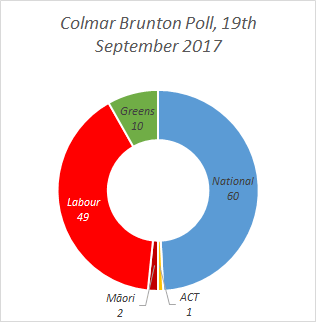 Let’s start by comparing the base seats we would expect to see in both of the major polls.
Let’s start by comparing the base seats we would expect to see in both of the major polls.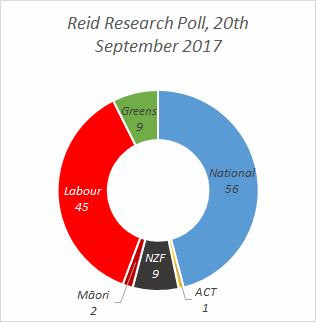 is capable of winning it on his own merits now as he is an incumbent, but assuming those things without a poll to back it up makes me very uncomfortable, and nobody polled Northland or Ilam this election, and these could reasonably be assumed to be key electorates. This scenario is a hung Parliament, assuming it is dead-on, (and of course, it won’t be) but once you factor in the margins of error, there are probably a lot more ways for a left-wing coalition to win than a right-wing one, as there are more ways for them to have been underestimated, if Peters did end up losing his electorate and below threshold.
is capable of winning it on his own merits now as he is an incumbent, but assuming those things without a poll to back it up makes me very uncomfortable, and nobody polled Northland or Ilam this election, and these could reasonably be assumed to be key electorates. This scenario is a hung Parliament, assuming it is dead-on, (and of course, it won’t be) but once you factor in the margins of error, there are probably a lot more ways for a left-wing coalition to win than a right-wing one, as there are more ways for them to have been underestimated, if Peters did end up losing his electorate and below threshold.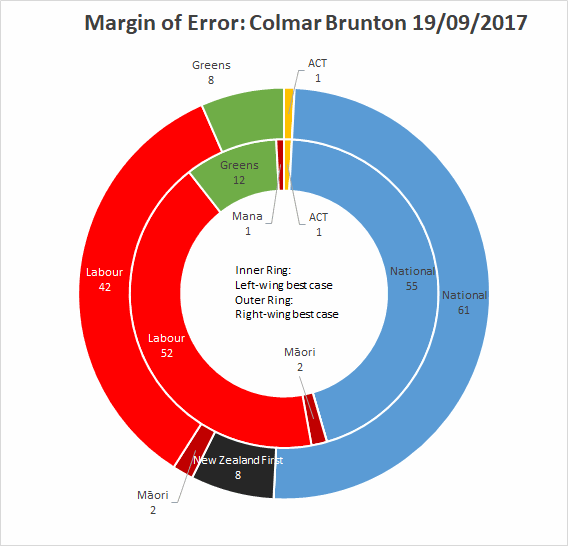
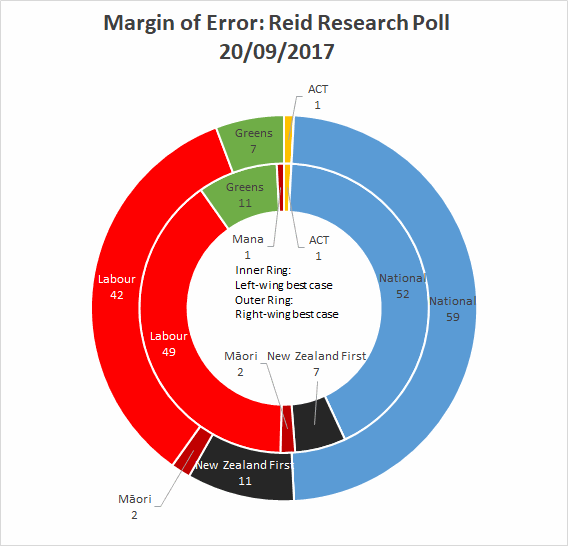
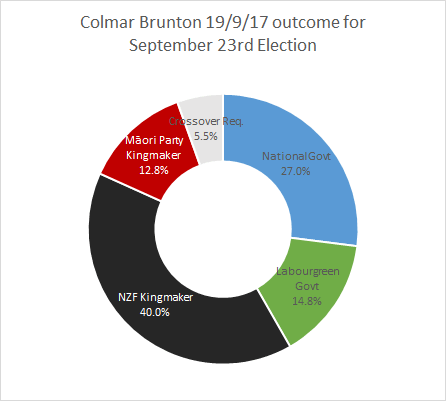
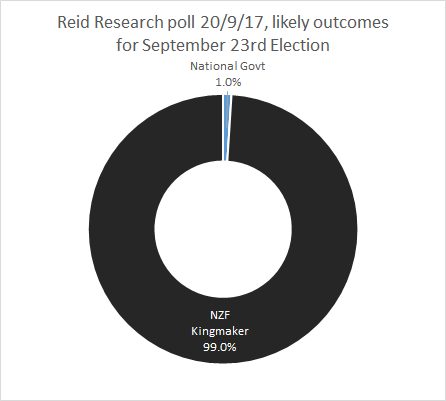 chance for ACT or the Māori party to lose electorates, and even for Mana to win Te Tai Tokerau)
chance for ACT or the Māori party to lose electorates, and even for Mana to win Te Tai Tokerau)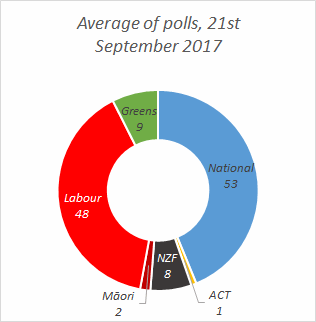 I have a healthy amount of skepticism about the changes to Reid Research’s poll methodology and the addition of online panels. While the two last results were superficially a bit similar, both the one-off Horizonpoll and Reid Research have been friendlier to National and New Zealand First than the other polls. It’s difficult to fairly compare Horizon without past results, but taken with its commonality with the two most recent Reid Research polls in showing either National or New Zealand First at unexpectedly high
I have a healthy amount of skepticism about the changes to Reid Research’s poll methodology and the addition of online panels. While the two last results were superficially a bit similar, both the one-off Horizonpoll and Reid Research have been friendlier to National and New Zealand First than the other polls. It’s difficult to fairly compare Horizon without past results, but taken with its commonality with the two most recent Reid Research polls in showing either National or New Zealand First at unexpectedly high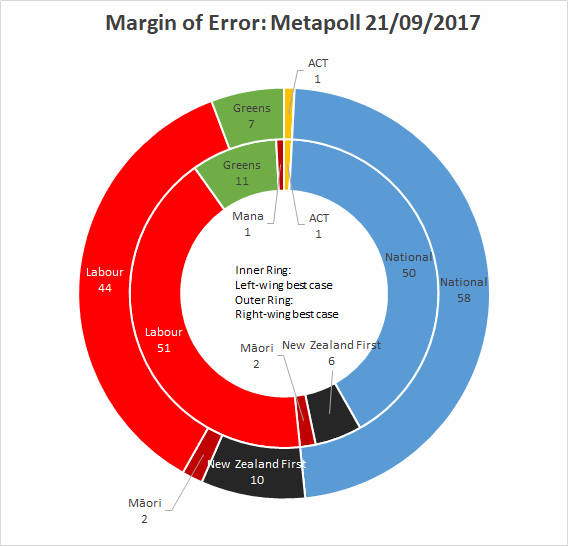 So that covers the last two polls. The average is, as you’d expect, somewhere between them, with a little weirdness thrown in from using the older polls to moderate them a little bit. When looking at the average we should consider the trend of the most recent polls, which both agree that Labour is dropping a bit, National is not as high as the two latest polls suggest, although maybe higher than the average does, that the Greens are rising, however they are in sharp disagreement about whether NZF is rising or falling, however not to the level where we can be sure the reality isn’t simply that they stayed still or rose very slowly from 6% to, say, 6.2%.
So that covers the last two polls. The average is, as you’d expect, somewhere between them, with a little weirdness thrown in from using the older polls to moderate them a little bit. When looking at the average we should consider the trend of the most recent polls, which both agree that Labour is dropping a bit, National is not as high as the two latest polls suggest, although maybe higher than the average does, that the Greens are rising, however they are in sharp disagreement about whether NZF is rising or falling, however not to the level where we can be sure the reality isn’t simply that they stayed still or rose very slowly from 6% to, say, 6.2%.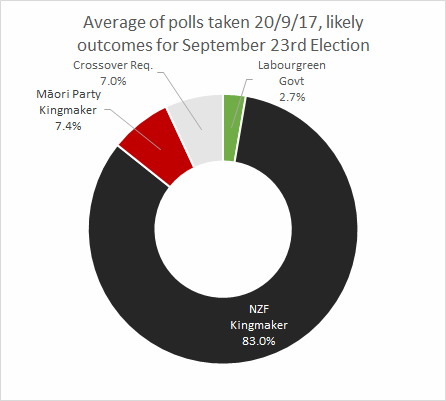 While it’s often said of the minor parties that NZF routinely underpolls and Greens routinely overpoll, this is not exactly true. What tends to happen is that NZF has an upward trend that may be explained purely in lag between the poll and changes in attitude of voters on election day, while the Greens are usually in a downwards trend on election day that might also continue. This year, NZF had been in a downwards trend until the very last poll, and the Greens were in a consistent upward trend, although all three big polling organisations disagreed as to how much. I wouldn’t be surprised if we see NZF poll at somewhere around 5-6%, and the Greens poll between 7-8%, but it’s possible that the saying really is true and we will see the reverse trend.
While it’s often said of the minor parties that NZF routinely underpolls and Greens routinely overpoll, this is not exactly true. What tends to happen is that NZF has an upward trend that may be explained purely in lag between the poll and changes in attitude of voters on election day, while the Greens are usually in a downwards trend on election day that might also continue. This year, NZF had been in a downwards trend until the very last poll, and the Greens were in a consistent upward trend, although all three big polling organisations disagreed as to how much. I wouldn’t be surprised if we see NZF poll at somewhere around 5-6%, and the Greens poll between 7-8%, but it’s possible that the saying really is true and we will see the reverse trend.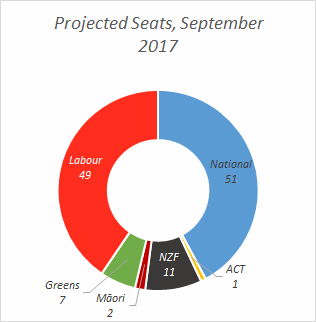 National: 41.5% ±3.05%
National: 41.5% ±3.05%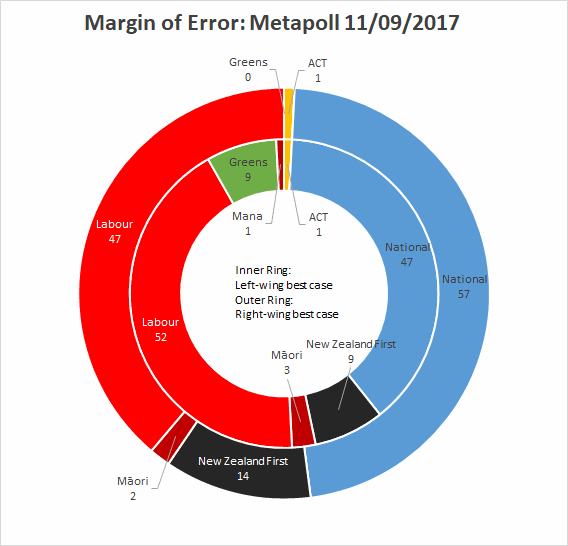 The first thing we need to look at is the margin of error.
The first thing we need to look at is the margin of error.